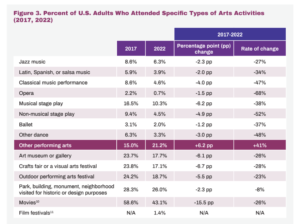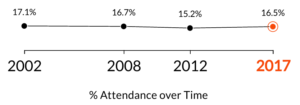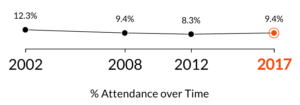Dunkirk NY – At first, I thought this next post in the series was going to be about the future of theatre as I see it. But it occurred to me that writing about the future is somewhat pointless if one does not have as a reference point the present state of theatre. So with that, here is a short but sweet post about the present theatrical situation as I see it.
As a prelude, let me say that I will be writing in broad generalizations and considering apparent trends. Some of what I will mention will be extrapolated conclusions from the 2022 SPPA. Other observations will come from news stories I have read. Little of it will come from direct experience, as my personal experience comes from my work in the Buffalo theatre community, which surprisingly continues to survive and even thrive (the last Artie Awards ceremony this past June sold out a 600-seat theatre). Real data is truly scarce in the theatre world, and so I will make do with what my limited resources allow me to perceive.
To begin with, I think there is no question that in 2023, theatre is struggling. Beginning in March 2020, when the pandemic hit and institutions everywhere and of every kind shut their doors, theatre was hit with a perfect storm. The pandemic closed theatres and thus their source of revenue; the social movements for diversity and inclusion began to infiltrate theatre at several levels, and the nature of theatre leadership began to change. It was an onslaught that nobody was prepared for, and it hit like a ton of bricks. Taking these three broad categories as our entry points, we can dig a little deeper into each category and check out how these events induced change and the struggle it wrought.
First, money. This one is easy. Once theatres closed and ticket sales vanished, theatre organizations were forced to cut staff, reduce shows, and beg for financial support (to the tune of millions and millions of dollars). This situation is ongoing. Most theatres today are struggling to re-capture their level of ticket sales from late 2019. Many have only gotten to the 50% mark. Many other theatres have outright closed shop. Several went into hibernation, suspending their operations until their finances could catch up. Other theatres have survived only because they have been able to raise large sums of money. Oregon Shakespeare Festival raised $9 million dollars over two campaigns to keep its doors open. Recently TheatreWorks Silicon in the San Francisco Bay Area raised $4 million to keep its doors open. But not all theatres can do that. It is becoming more and more apparent that the cost of producing a show continues to rise, as do ticket prices. In this inflationary period, however, less and less people can afford the cost of a ticket, and the breaking point where ticket prices are too expensive for all but the top 5% of earners butts up against the inability to earn enough income to meet costs of production is close at hand, if not already here.
Second, the cultural movement behind the notions of inclusion, diversity, equality and accessibility (the acronym IDEA) began to infiltrate every aspect of theatre. The theatre was perceived to be run by the white patriarchy, and those people who had previously felt excluded began to push for more IDEA in theatre. Actors’ Equity is an example of a theatre-adjacent organization that was forced to re-consider itself as an organization that had contributed to the exclusion of minorities in its membership, and so chose to open its membership to all actors who basically had ever been paid to act. Casting shows so as to provide more opportunities for minorities to perform became a larger trend than it already had been, but apart from that, placing minorities into positions of leadership became more and more prevalent. The content of plays also began to have a different shape. Plays telling stories from many other cultures and traditions began to appear on stage. Plays by African-Americans, Hispanics, Asians, Native Americans, and other people of color started appearing in theatres.
Lastly, theatrical leadship structures began to change. Broadly speaking, the theatre went from a leadership structure where one person, deemed the “Artistic Director,” decided everything about a theatre’s season, from which plays were done to who directed which plays and what actors might appear in them. Essentially, the Artistic Director was viewed as a (hopefully benevolent, but not always so) autocrat whose word was law. Over the past few years though, that model is being consigned to history, as more and more, leadership at theatres consists of committees of panels or some other communal structure where everyone’s interests are at least heard and considered, if not always put into practice. Artistic directors are not quite ruling the roost as they once did, having in many cases now to answer at least to a panel of some sort so their ideas can gain buy-in from all stakeholders.
None of all this can be said to be the cause of people no longer choosing to attend theatre, but given the large decreases in theatre attendance as surveyed by the SPPA, we should at least understand that all these forces probably play a part in creating a situation where people choose not to attend theatre. Theatre is expensive, and so young people tend to be priced out of the market. Seniors who endured through the pandemic have found other means of entertainment, and with so much entertainment available at home, they are choosing less and less to go out. Seniors are also dying, and young people are not taking their places in the seats. People who view theatre as an opportunity to escape their lives and seek some enjoyment do not want to see IDEA-based politics reflected on the stage. And for the most part, theatre is inaccessible, mostly located in geographic areas where people do not wish to travel or are difficult to get to. Put another way, theatres are generally located in “cultural” areas, and not “community” areas.
I think the best way to describe the present landscape of theatre is that it is struggling. It is struggling internally in terms of finances, leadership, IDEA, and content. It is struggling externally to find an audience that will sustain it financially and culturally. The analogy for my current relationship with theatre is that of two people drowning in the ocean. One is doing their best to calmly stay afloat, while the other is thrashing about in the sea. The one calmly floating is keeping a wary distance from the thrasher, because they know that if they get close and try to save the thrasher, both will drown. Even though I have spent the better part of 50 years participating in the theatre, right now I am keeping my distance for fear of getting caught in the struggle and drowning.
What will become of this struggle? That, I think, is the subject of the next post. If we have at least a broad contour of the present situation, we are in a better position to consider what the future may bring. Hint: I don’t think it will be pretty. -twl





